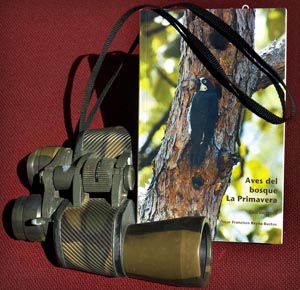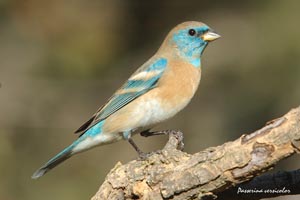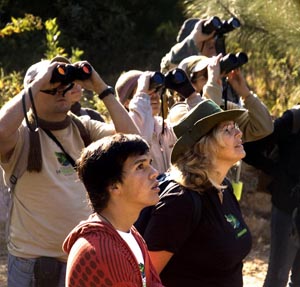A boon to birdwatchers in Western Mexico

The Primavera Forest is a protected area of oak and pine trees covering over 36,000 hectares, located due west of Guadalajara, Mexico’s second largest city. In 2010, the administrators of the forest published Aves del Bosque La Primavera-Guía Ilustrada (Illustrated Guide to the Birds of the Primavera Forest) by Oscar Reyna Bustos. Nature photographer Jesús Moreno described the book as “The fruit of many years of hard work and a great deal of time spent in the field.”
The guide is, indeed, jam-packed with 197 color photos and descriptions of birds you can spot in the Primavera Forest, from plain wrens and sparrows to more exotic or curious birds like the Lesser Roadrunner, the Mexican Parrotlet and the Painted Bunting. By the way, from this book I learned that the latter is called Colorín Sietecolores (seven-hued goldfinch) in Spanish, but Oscar Reyna’s detailed description of this beautiful bird suggests it proudly displays at least ten different colors, despite its name.
Let me start off by mentioning that even though this bird guide is in Spanish, it includes the English names of all the birds listed and its photographs will be extremely useful to speakers of any language. The book appears to have been published by the author with the financial backing of the city of Zapopan and the collaboration of the Primavera Forest Service, as well as the University of Guadalajara. It’s a paperback with 221 glossy pages and convenient front and back flaps for marking your place. It measures 22.5 by 15 by 1.2 centimeters, weighs around half a kilo and carries ISBN number 978-607-00-3881-5.

Each bird gets a page all to itself with a color photo, description and the other basic information all in Spanish. In addition, there are helpful silhouettes (by Karina Aguilar) of the 15 orders of birds represented. The heading of each page includes the order and family of the bird along with its Spanish, English and scientific names.
According to Mexican ornithologist Enrique Valdez, “Field guides for small areas like the Primavera Forest present certain advantages: they are lightweight and easy for beginners to use without the bewildering options that could cause a birder to start banging his head against a tree. The disadvantages: they’re only good for one particular place and don’t include accidental species which often pop up.”
Fortunately, in this case, Oscar Reyna has taken pains not only to include the Primavera Forest’s 162 “residents” but also 35 of these “accidental species,” bringing the total number of birds covered to 197.
Oscar Reyna decided to illustrate his book with color photographs, a choice that surely cost him many years of patience, sweat and tears (especially where he has caught both the male and female of the species in the same picture). While photos show the birds as they really are, they don’t let us see all the essential details, as do drawings…but, then, coming up with 197 accurate drawings may be an even more daunting task than taking 197 quality photos of our shy, elusive feathered friends.

One notable problem with this book is that it does not have an alphabetical index. So, if your nephew Gerardo shouts, “Caray! I think I just saw a kingfisher!” there is no easy way you can quickly go to the photo of a Green Kingfisher on page 87 of this book. No, you are obliged to start hunting through a seven-page list of the book’s 197 birds, a list organized by order and then by family. This means you could only find that Kingfisher if you knew that it is a Cerylina of the family Alcedinidae of the order Coraciiformes. Well, if you happen to know all that, you are surely not a principiante (beginner), for whom this book was written.
To rectify this error, I have typed out an alphabetized list of the English names of these birds with the page numbers you need (below). This you can print out at home and paste it into the back of the book.
Despite this omission, the new bird guide is a great book, but it may be difficult to find a copy of it. Try calling the Primavera Park Service at (52) 333 110-0917 / (52) 333 110-0917. If you live in Guadalajara, you may want to sign up for the Club de Observadores de Aves de la Primavera, which includes beginning, intermediate and expert birdwatchers and meets monthly. For more information on the Club, contact Francisco Leon, [email protected].
Short ‘n’ Easy Alphabetical List of Birds
Short ‘n’ Easy Alphabetical List of Birds in the book Aves del Bosque de la Primavera (By English group names of the bird only, for example: kingfisher, woodpeckers etc.)
| Ani 70 | Herons 39-42 | Robins 140, 141 |
| Becard 114 | Hummingbirds 77-84 | Sandpipers 58, 59 |
| Blackbird 184 | Jay 121 | Seedeater 165 |
| Bluebird 135 | Kestrel 54 | Shrike 115 |
| Bobwhite 36 | Killdeer 57 | Silky-flycatcher 146 |
| Buntings 180-182 | Kingbirds 110-113 | Siskin 195 |
| Bushtit 127 | Kingfisher 87 | Solitaire 136 |
| Caracara 53 | Kinglet 134 | Sparrows 166-175, 197 |
| Chat 163 | Kiskadee 107 | Swallows 123-125 |
| Cowbirds 186, 187 | Kite 45 | Tanagers 176-177 |
| Creeper 128 | Magpie-jay 120 | Thrasher 143 |
| Crossbill 194 | Meadowlark 183 | Thrushes 137-149 |
| Cuckoo 68 | Merlin 55 | Titmouse 126 |
| Doves 62-66 | Mockingbirds 142-144 | Towhee 167 |
| Egrets 38-40 | Motmot 86 | Trogon 83 |
| Euphonia 192 | Nightingale-thrush 137 | Vireos 116-119 |
| Falcon 56 | Orioles 188-191 | Vultures 43, 44 |
| Finch 193 | Owls 71-75 | Warblers 147-162 |
| Flicker 92 | Parrotlet 67 | Waterthrush 155 |
| Flycatchers 95-109 | Pewee 96 | Waxwing 145 |
| Gnatcatcher 133 | Phoebe 103 | Whip-poor-will 76 |
| Goldfinch 196 | Pigeons 60-61 | Woodcreepers 93, 94 |
| Grackle 185 | Quail 37 | Woodpeckers 88-91 |
| Grassquit 164 | Raven 122 | Wrens 129-132 |
| Grosbeaks 178, 179 | Redstarts 160, 161 | Yellowthroat 157 |
| Hawks 46-52 | Roadrunner 69 |


En dónde puedo comprar la guía?
No estoy seguro si los números siguen siendo correctos, pero intente llamar a Primavera Park Service al (52) 333 110-0917 / (52) 333 110-0917. Alternativamente, el Club de Observadores de Aves de la Primavera puede conocer – Francisco León, [email protected].